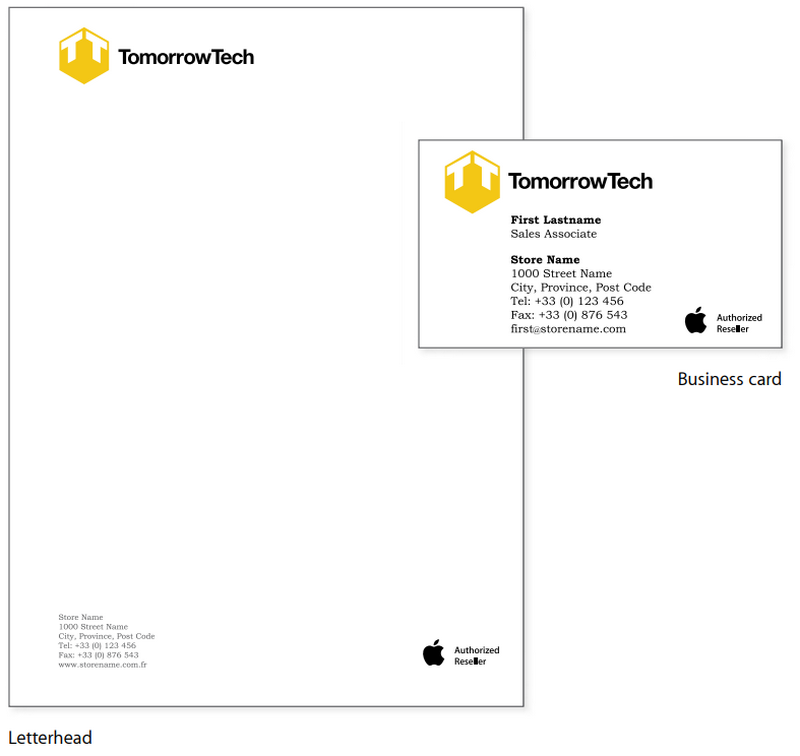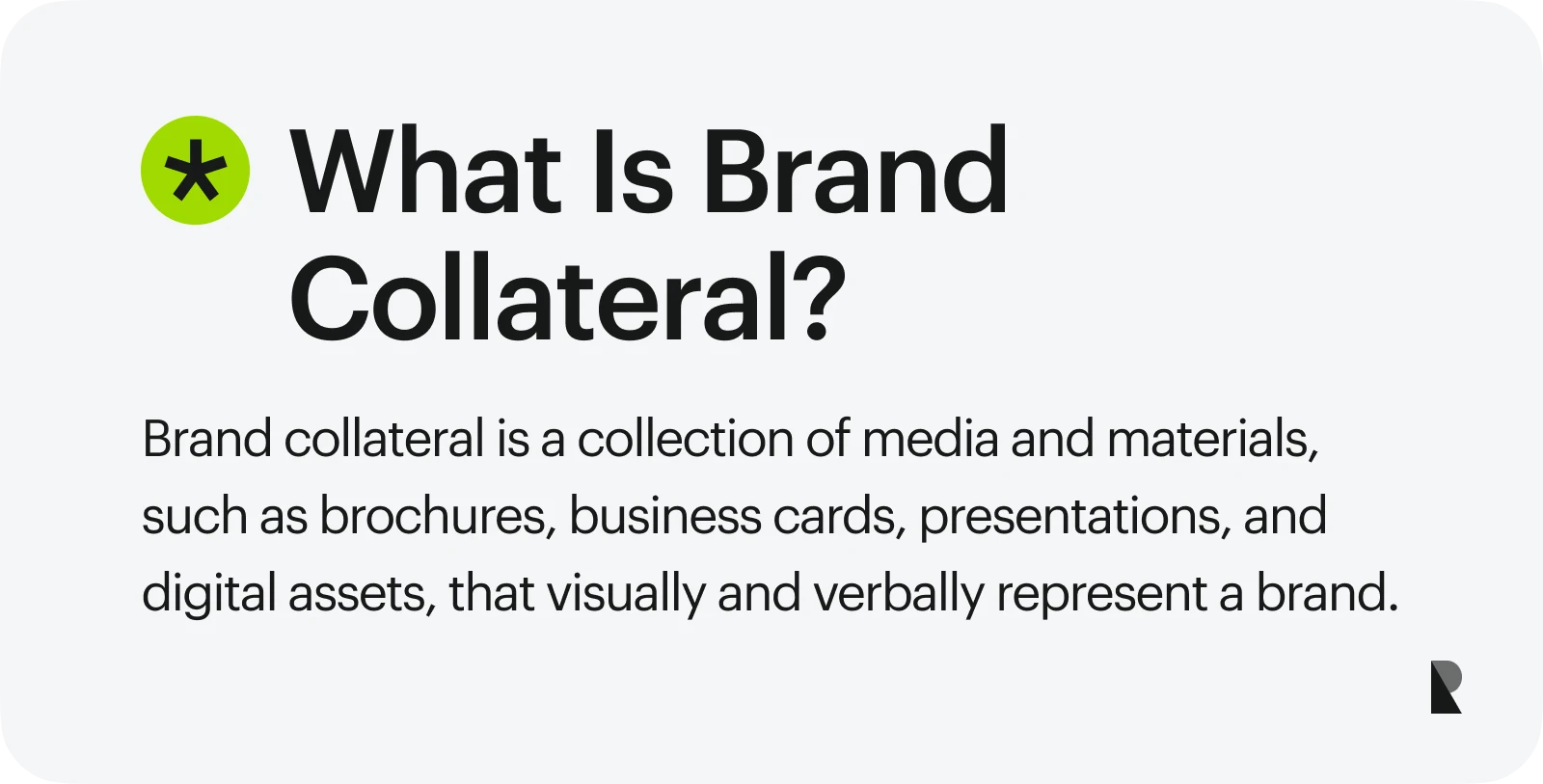
With over 100 million active trademarks worldwide, we are inevitably exposed to them. According to studies, a regular person encounters thousands to tens of thousands of ads daily. This is achieved intentionally, when a person seeks information to address a specific pain point, and unintentionally, when using products in their daily routine, such as choosing a particular brand of coffee for breakfast.
However, even though brands surround us, it takes 5-7 interactions with the company and its product for people to remember it. With the increasing information overload, this number continues to grow as people become more distracted and overwhelmed by the numerous offerings on the market.
This presents significant challenges for entrepreneurs, not only in starting a new business but also in maintaining the viability of their well-established one. It is here where brand collateral enters the game, helping owners to restate their position, strengthen their relationships with clients, and move forward.
For many businesses, developing cohesive and effective brand collateral can be overwhelming without expert guidance. Partnering with a brand identity agency ensures that every visual and verbal element aligns with the company’s strategy and market positioning.
So, what is brand collateral, why is it important, and how do you introduce it in your strategy? Let's explore this remarkable and time-proven concept a bit more.
Defining Brand Collateral
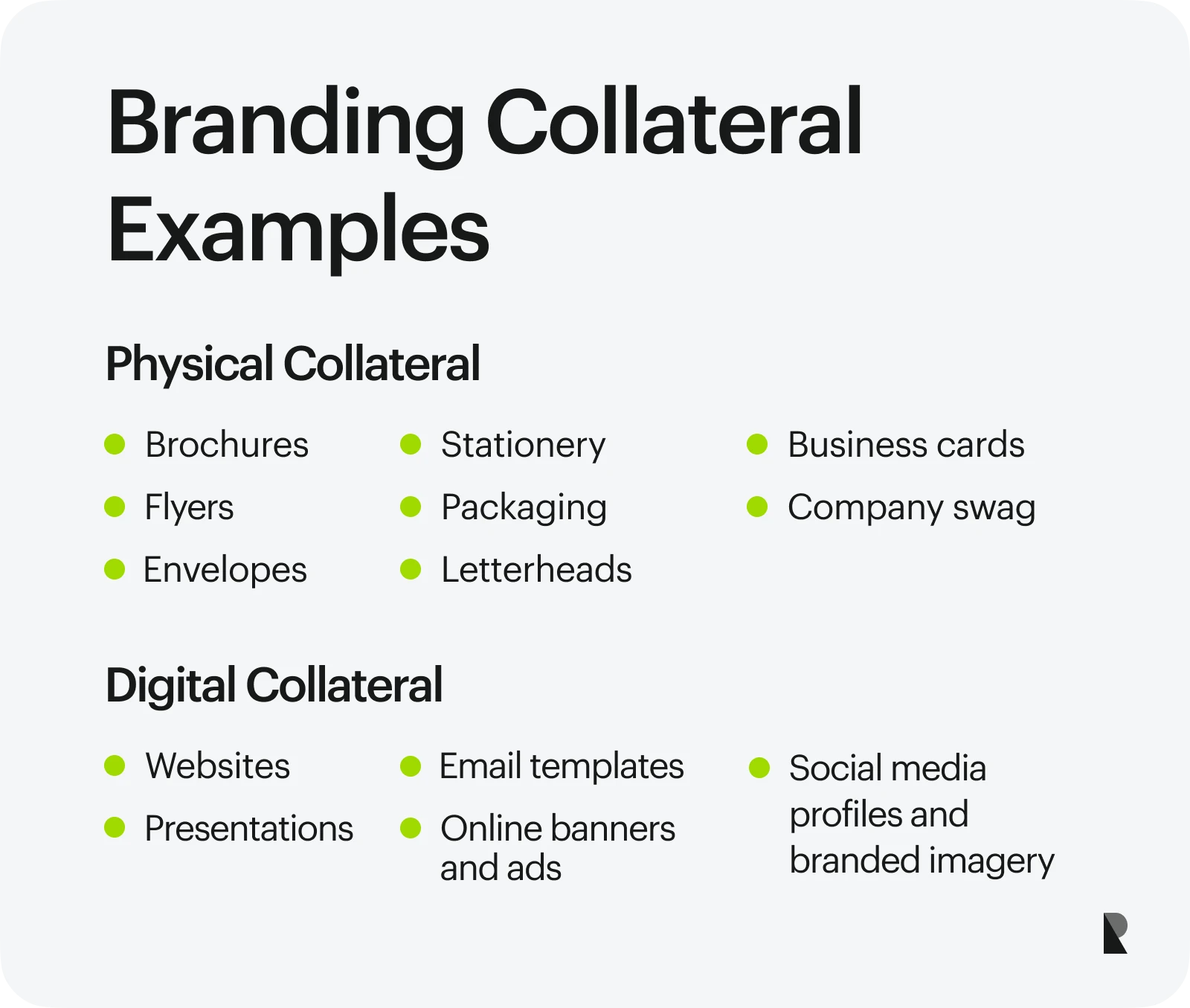
Every time clients and prospects interact with a company or its products, whether in a brick-and-mortar store, on social media, or the website, they establish a meaningful connection and reinforce their association with the brand's identity, image, and reputation.
Marketing collateral comes in all shapes and sizes, covering diversified means of interaction with the target audience and providing visual, verbal, or other sensory cues during communication. It falls into two basic categories: physical and digital.
The popular physical branding collateral examples are:
- Brochures,
- Flyers,
- Business cards,
- Letterheads,
- Envelopes,
- Packaging,
- All sorts of stationery (like notebooks or pencils),
- Company swag (mugs or t-shirts).
The popular digital marketing collateral examples are:
- Websites,
- Banners and ads,
- Presentations,
- Social media profiles and imagery,
- Email templates.
Additionally, brand collateral encompasses essential elements of both physical and digital assets. This includes the logotype, brand color scheme, mascot, tagline, slogan, signage, and font face.
Digital vs. Physical Brand Collateral
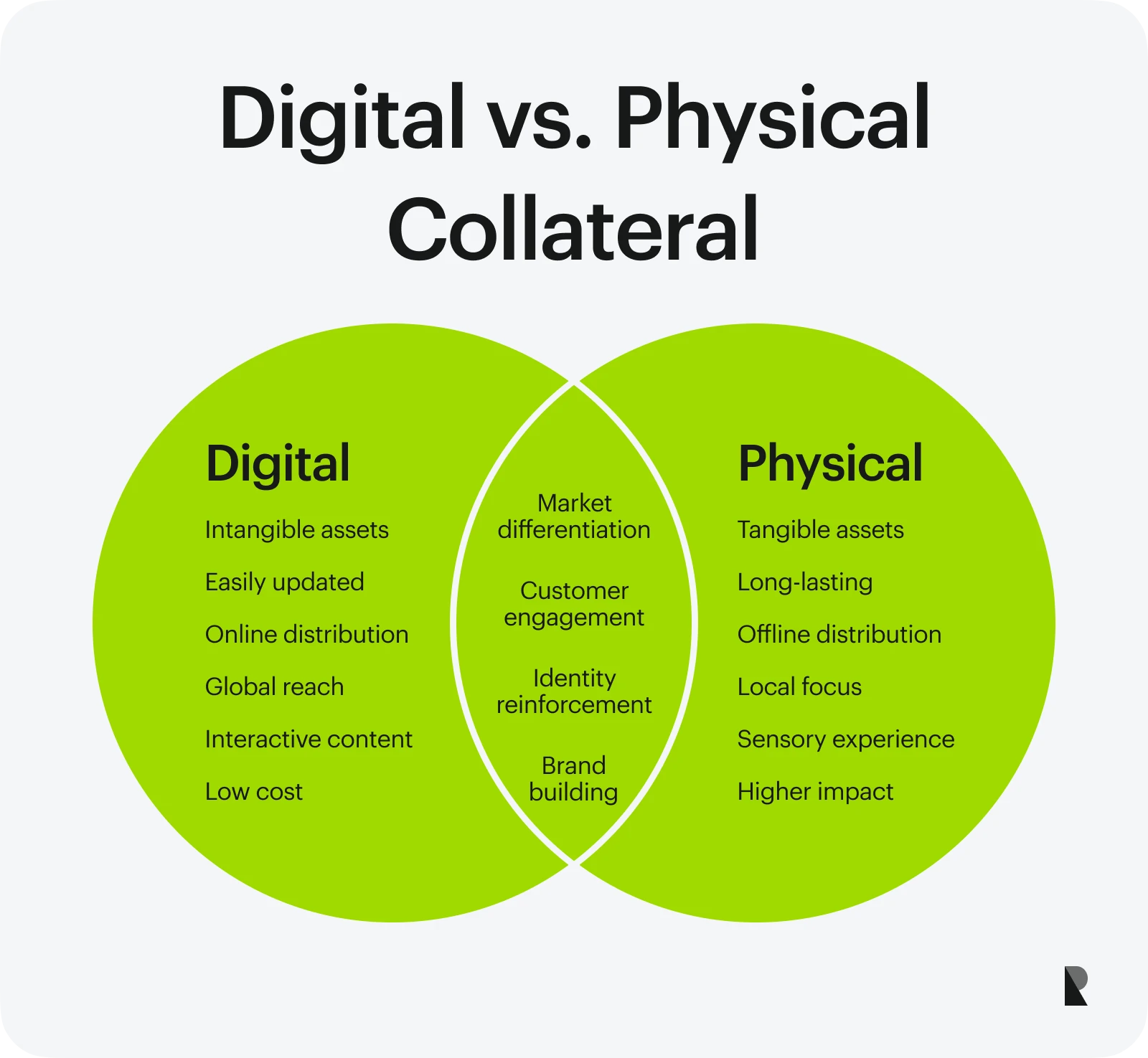
Marketing collateral is the core of branding. Without it, there is not much of a brand. It is the primary tool for delivering the company's mission, vision, message, and identity to the target audience. It differentiates the company from the competition and strengthens its market position. Coming in two general formats, it underlies the company's efforts in various directions.
However, even though all elements of brand collateral work towards the same goals (aka building and reinforcing the company's identity, establishing strong relationships with customers, and visually separating the company and its offerings from the others), these two categories still have different purposes as they help the company to achieve its objectives in various ways.
Here is a digital and physical collateral comparison table to help you better understand their differences.
| Aspect | Digital | Physical |
|---|---|---|
| Format | Intangible assets that could be present in different digital formats. It could be an image, illustration, graphics, profile, template, catchphrase, video, or audio. | Tangible assets that have a physical presence and can be touched, seen, or held. Good examples include branded merchandise (such as mugs or t-shirts), print marketing materials (flyers, posters, or catalogs), signage (banners), exhibition displays, packaging, product samples, and equipment. |
| Durability and updates | It is temporary, easily updated and adjusted to mainstreams and trends. | It is relatively permanent and rarely adapted to trends. |
| Distribution | Distributed through digital means of communication: websites, social media, email marketing campaigns, online ads, and videos. | Distributed through physical means in stores, malls, or by post. |
| Audience experience | It targets a wide audience with the ability to cover the international market. | It targets the local audience. |
| Advantages | Interactive (enhance visual experience, drive engagement, reinforce online presence), track engagement, low production and distribution costs. | Perceived as more trustworthy,can be kept, shared, and passed along, offer a sensory experience, more impactful for a small audience. |
| Effectiveness | Effective for digital events and conferences, digital communication, chats, and search engines. | Effective for events, trade shows, conferences, and in-store experiences and promotions. |
Main Types of Brand Collateral
With a millennia-long history, marketing collateral assets are wide-ranging, from a simple logotype stamped onto a wrapper to an ultra-sophisticated interactive game that guides users through the company's story. While this diversity could be increasingly beneficial for companies, as they may find the best method to deliver their message and vision to the target audience, it can also be overwhelming. To avoid confusion, we have listed common categories and their popular representatives.
Stationery
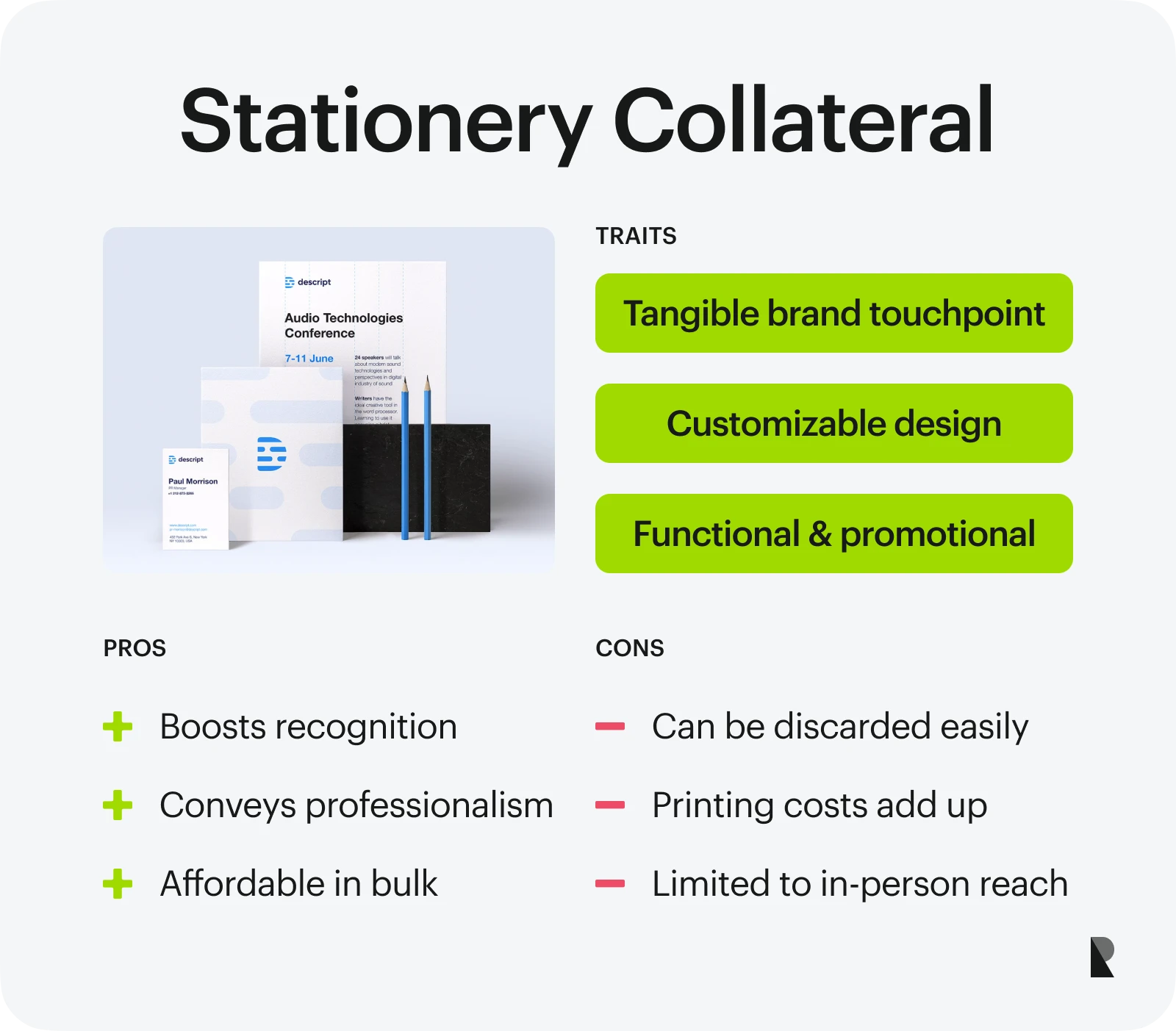
This is the most popular category of print brand collateral. It includes business cards, newsletters, envelopes, and notepads. It is a time-proven way to increase brand awareness, leave a long-lasting impression, and create a professional image worldwide. Companies generally utilize them during conferences, meetings, and events.
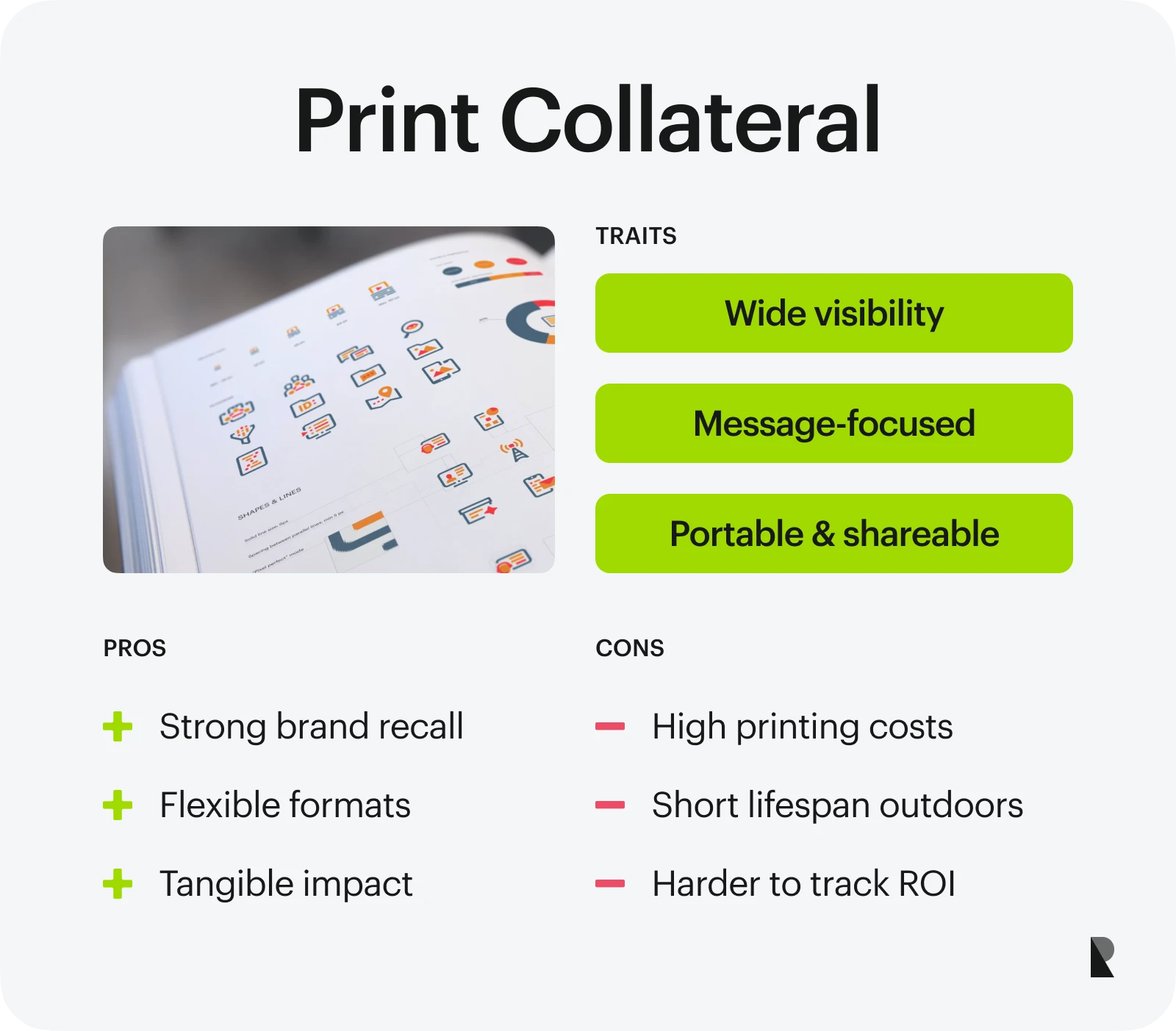
Print media is another popular marketing collateral type that has been around for ages. It includes brochures, flyers, posters, mailers, and others. Print media generates buzz around the brand or product, delivers the brand vision and message, and boosts brand recognition and recall. You might encounter it everywhere on the street, in stores, or at events.
Branded merchandise
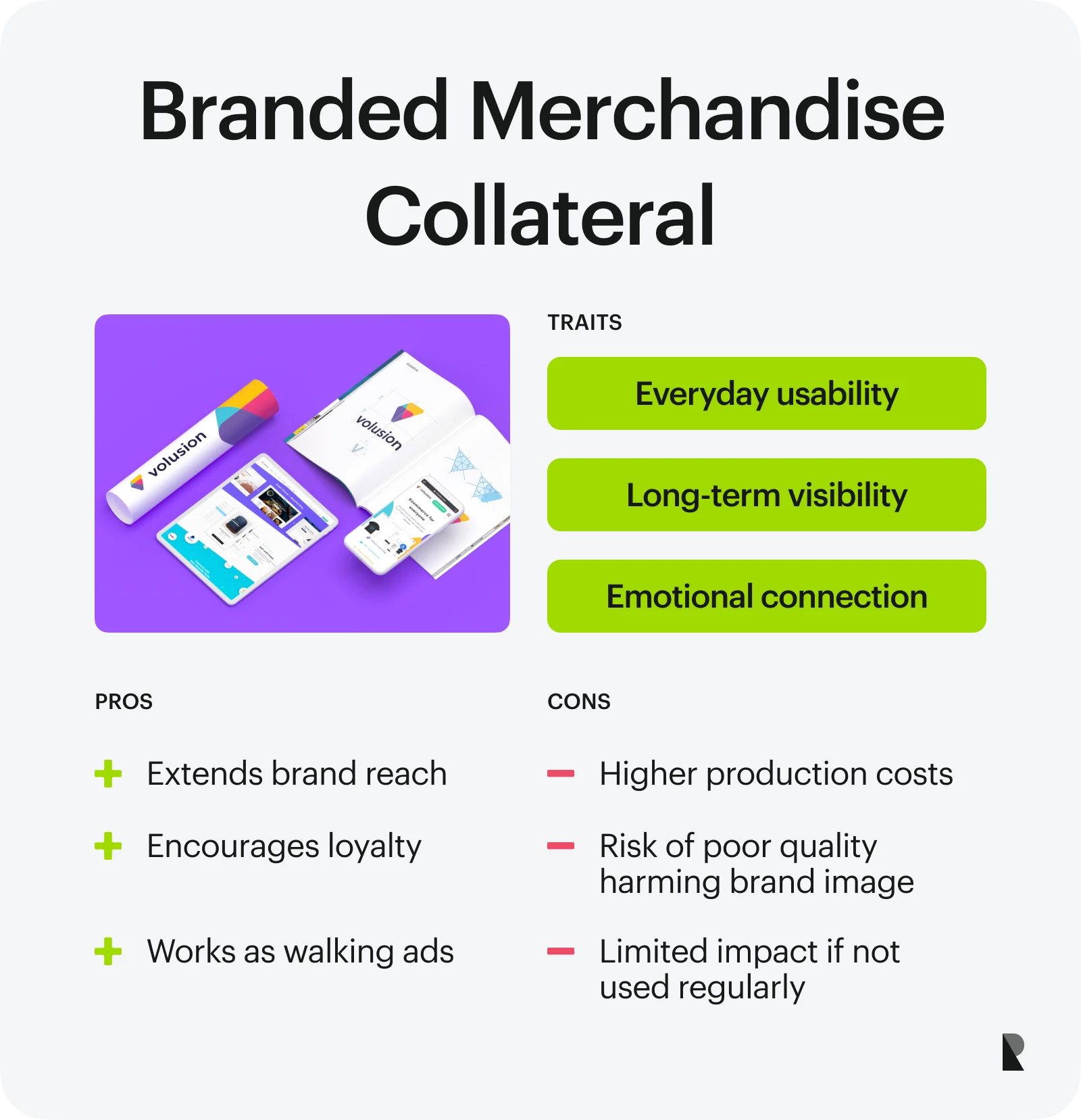
This brand collateral provides consistent exposure to your logo, slogan, or mascot and is increasingly popular with companies during events and conferences. It includes POS materials, pens, banners, tote bags, bottles, mugs, hoodies, t-shirts, and more. It is excellent for team building, brand advocacy, and generating conversions and leads.
Publication
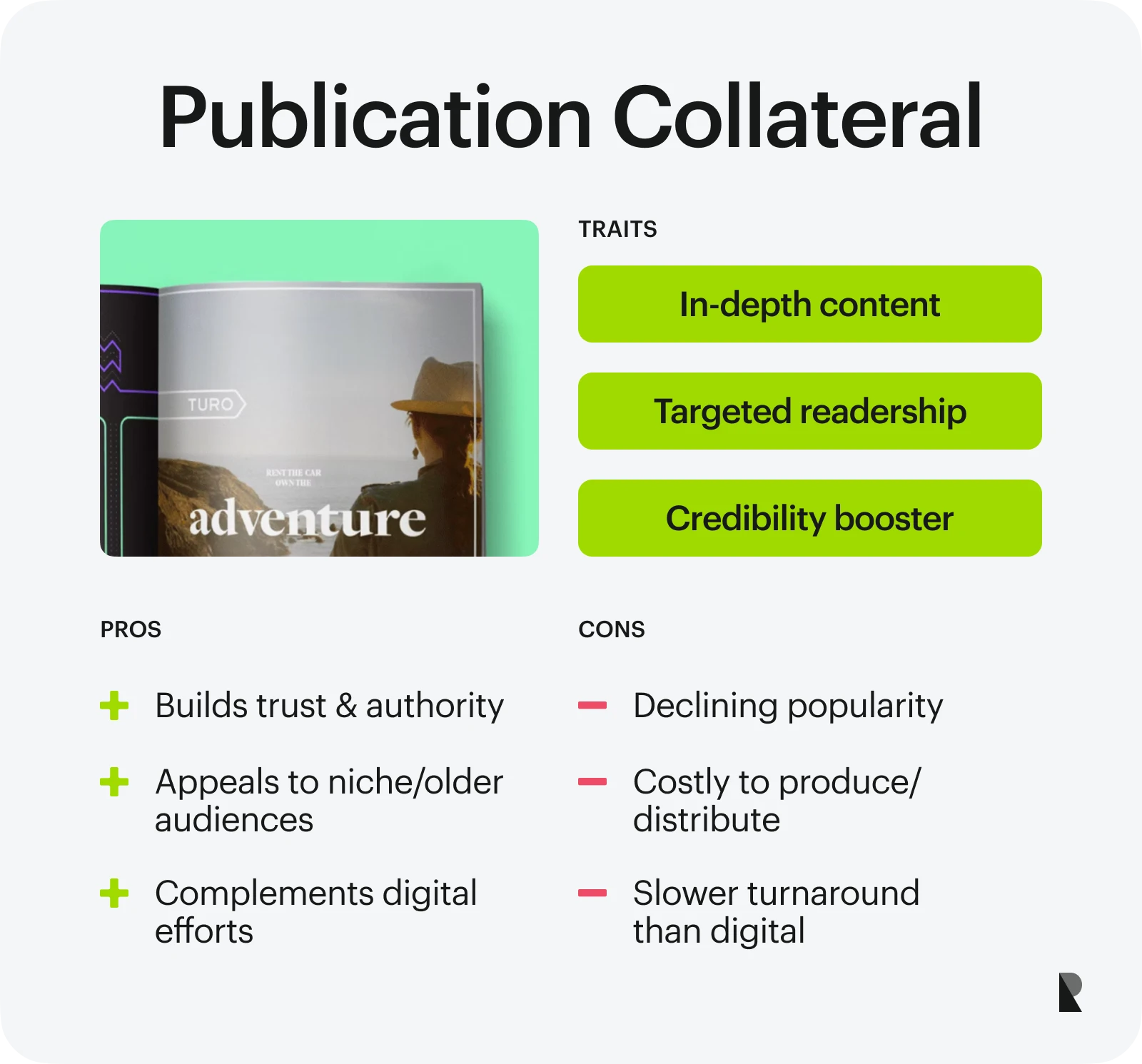
Once a primary driving force for conversions, publications have lost their strong position, but they remain the sought-after method to draw attention to the company and its products. The most popular representatives of this category are press ads, magazines, editorial, and reports. It effectively achieves such goals as reaching specific market segments (especially older generations), fostering trust and loyalty, and complementing digital branding and marketing efforts.
Digital
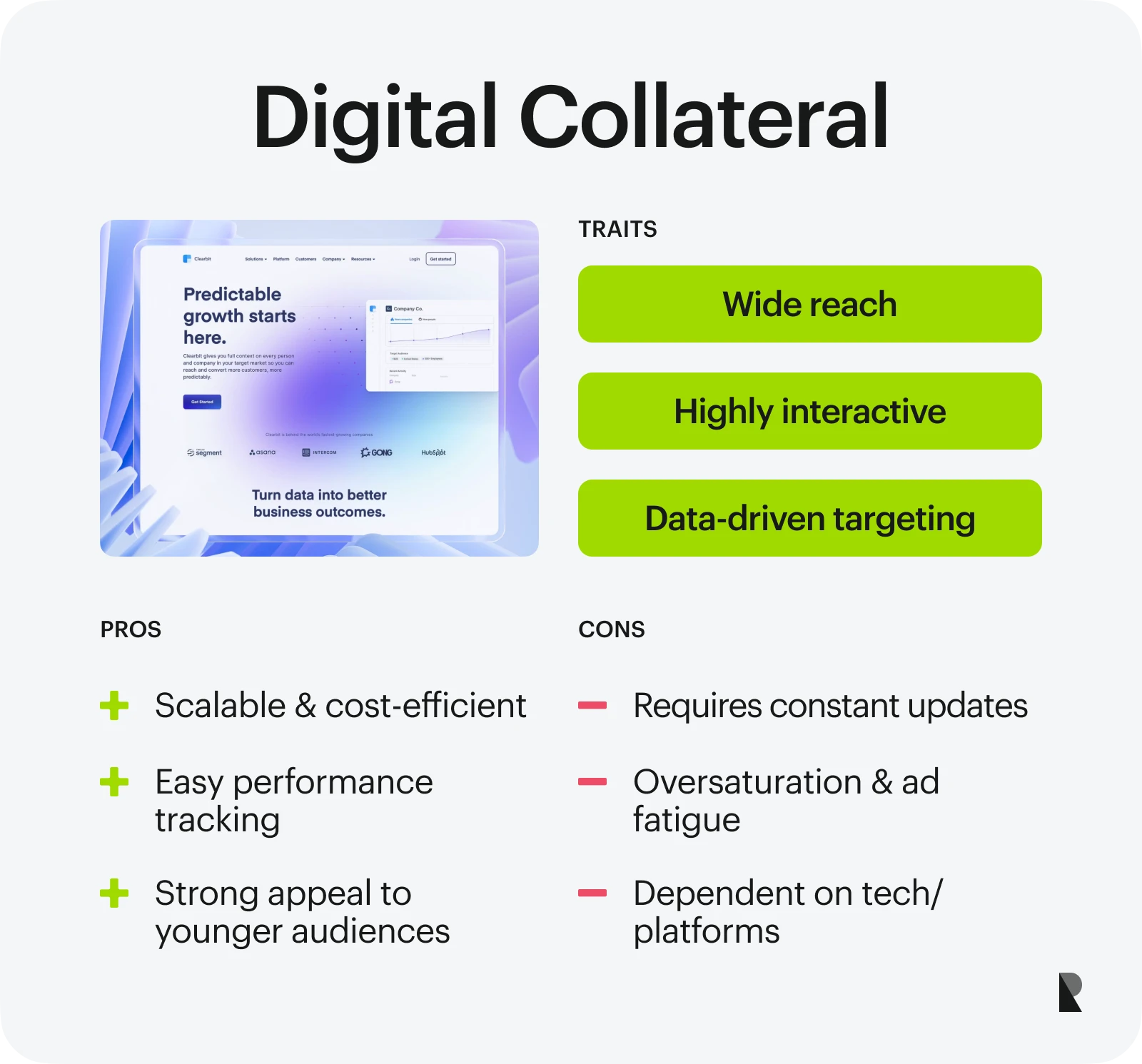
Online marketing collateral has a promising future as more people become comfortable communicating with brands through gadgets and media platforms. It includes online advertisement, animated content, websites, display advertising, landing pages, templates, digital newsletters, ebooks, digital brochures, videos, and audio. It effectively targets younger generations, reaches a broad audience, and makes a powerful first impression.
Signage
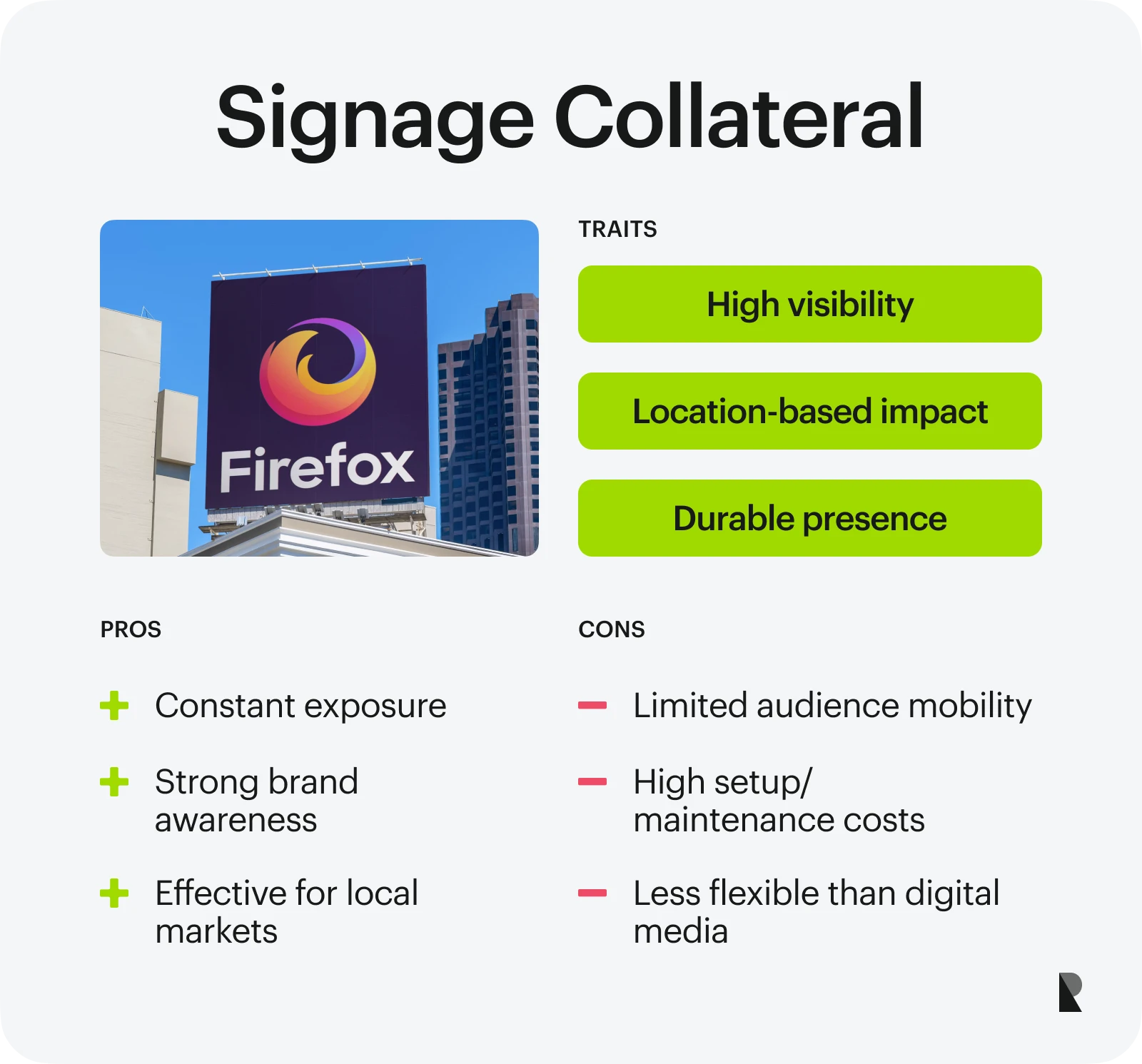
An oldie but goodie type of brand collateral remains one of the most popular ways to drive engagement, boost the brand's visibility, and establish a strong market position. It includes wayfinding, external and internal building, exhibition displays, and vehicle livery.
Presentations
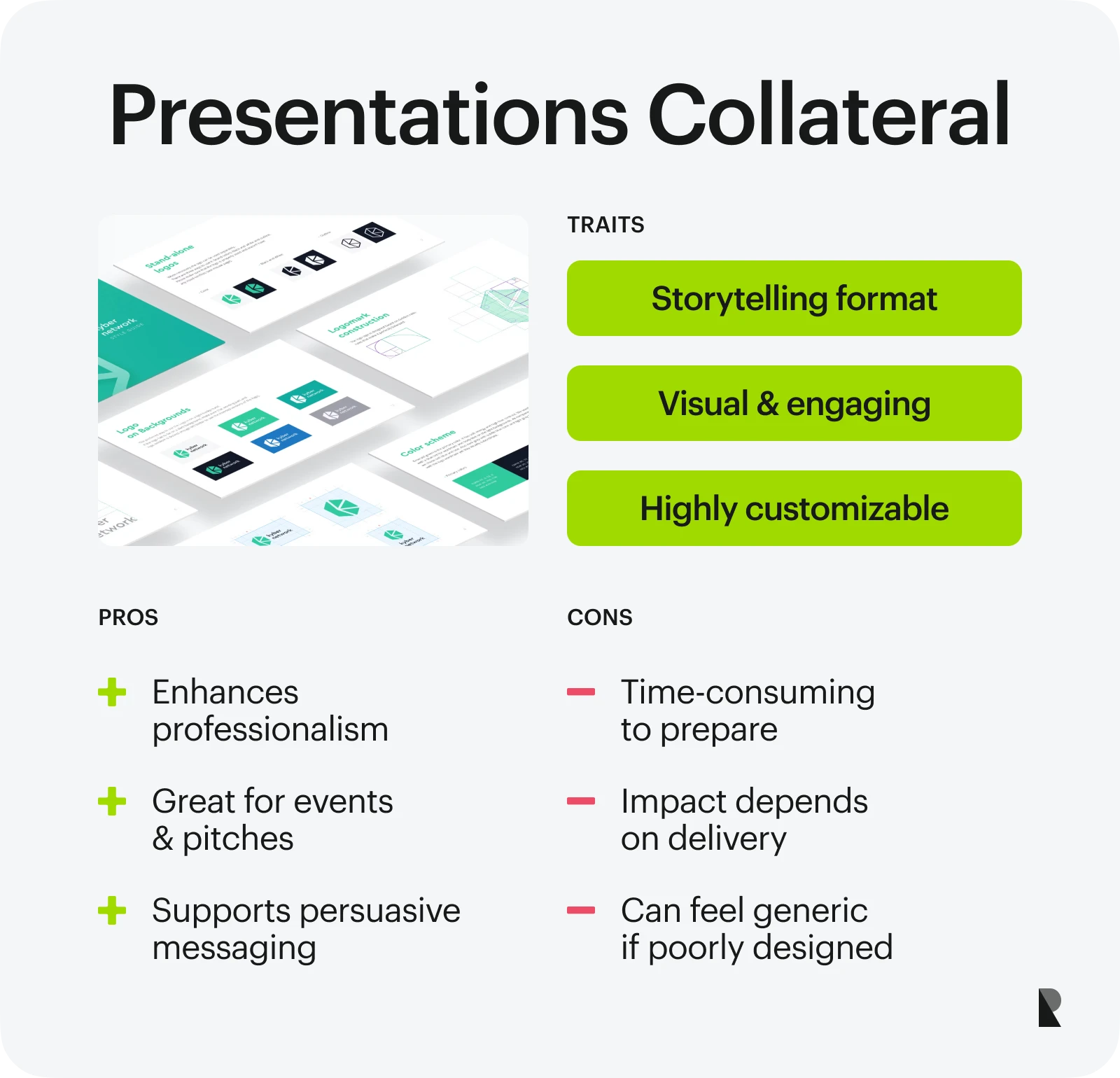
Presentations are one of the leading types of marketing collateral. They enhance the company's professional appearance through an engaging, branded storytelling experience. They are popular with large companies and organizations that host numerous events and conferences. Presentations include PowerPoint templates, showreels, videos, and imagery.
Packaging uniforms and IDs
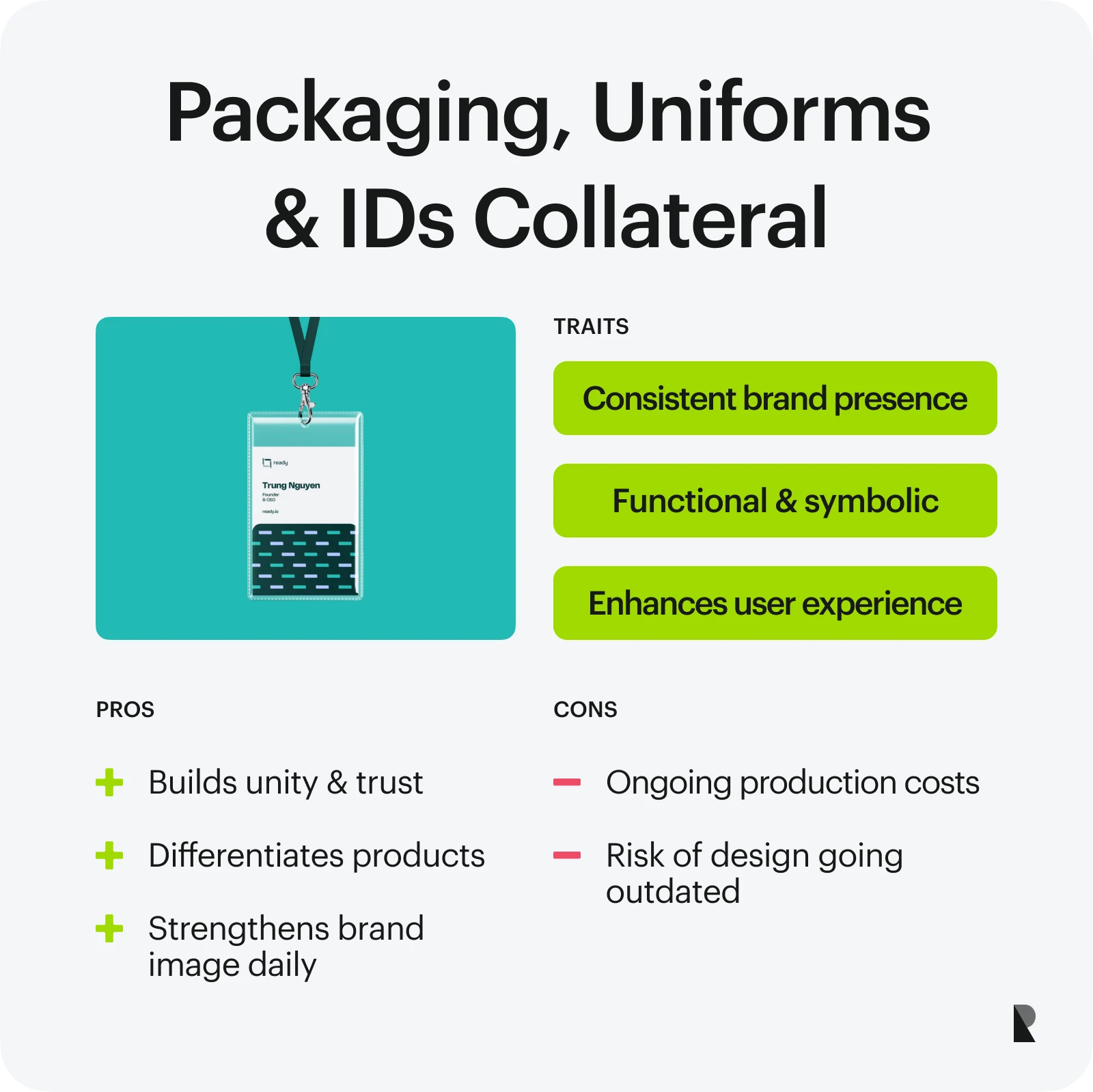
Branded packaging, uniforms, and IDs are cost-effective ways to emphasize your brand's vision and ideology consistently. They can also create a competitive edge, build a strong community within the company, and cultivate a sense of unity and belonging among clients. Branded packaging also helps products stand out and offers users an exceptional experience.
Why Invest in Strong Brand Collateral?
With such a great diversity of marketing collateral assets, it may seem overwhelming for companies to create, manage, and adjust to relevant market trends, especially without a professional brand design agency. However, as a fundamental block, it is critical for a company's successful existence in the industry.
Brand collateral is the cornerstone of advertising, branding, and marketing. It performs many essential tasks. First and foremost, it underlies the company's efforts to build a strong and enduring brand identity. Second, it boosts brand recognition and reinforces associations with the company. Third, it promotes growth and development. Fourth, it builds trust through high-quality, consistent, branded communication and audience interaction. Finally, it visually distinguishes the company from its competitors.
Adequate brand collateral is designed to perform all these essential tasks, empowering a company to achieve its short—and long-term goals, such as generating conversions, sales, and revenue, and becoming more desirable for investments and potential talents.
Consider brand collateral examples from industry leaders who have successfully adopted this concept. Take Apple, for instance. The company is renowned for its commitment to minimalism and perfection, which is evident in its products and presentation methods, including websites, events, keynotes, social media profiles, packaging, and even the design of its store interiors and employee uniforms. Whenever you interact with this brand, you know it's Apple.
Evolution of Brand Collateral
The changing landscape of brand marketing could not help but influence marketing collateral. Starting as primitive yet vital markings, such as cattle brands used to identify ownership, they have evolved considerably, becoming powerful tools to support marketing and advertising efforts.
In the modern sense, brand collateral emerged in the 19th century with the advent of industrialized printing methods, such as the steam-powered press. They began to shape the future of brand strategies. They laid a solid foundation for raising awareness and building the company's recognition through physical methods of communicating the brand's message and values, such as brochures, flyers, sell sheets, and business cards.
This direction has been expanding considerably, providing companies with diverse methods for advertising and marketing. It was not until the Internet era that digital marketing collateral emerged. With the global digitalization and the gradually expanding reach of the target audience, more companies have shifted to digital brand collateral materials, which include website designs, email campaigns, online advertisements, YouTube videos, social media profiles, animations, presentations, games, and various forms of imagery, designs, and visuals.
There is more. As VR becomes more stable and data analytics become more accurate, marketing collateral can be expected to become even more sophisticated. Industry leaders have already employed these new technologies to create more immersive and personalized brand experiences for their clients, leaving a long-lasting impression about their brand and products.
How Branding Drives Collateral Creation?
It must be aligned with your brand identity to ensure your marketing collateral is easily recognizable, evokes the correct associations and emotions, and supports your marketing and advertising endeavors. Each piece of collateral, whether it is a packaging design featuring your logotype or a social media banner, must accurately and unobtrusively convey the core message, reinforce the image and reputation, remain consistent with the delivery and company's image and reputation, and provide a cohesive and recognizable brand experience.
Brand identity reflects a company's vision, mission, ideology, personality, archetype, value proposition, and short—and long-term goals. It has a significant impact on the creation of print and digital media. Along with brand guidelines and marketing strategy, it provides a solid framework for brand collateral. Together, they navigate all the details by dictating rules and preferences for color scheme, fonts, logotype, material selection, brand voice and tone, messaging, design, and even the type of digital platforms.
Therefore, starting with a clear brand platform, a thorough understanding of your company's personality and vision, and a well-devised brand guideline and strategy is crucial. Please consult with the top brand design agencies to understand what marketing collateral your company needs and how to incorporate it into your plan.
Ensuring consistency: visual identity and messaging
A logo, color palette, and tone of voice are not just elements of a brand's visual identity; they are the cornerstone of consistency that must be maintained in the company's endeavors across multiple communication channels and interaction points. By using them regularly, the company creates a unique visual language associated with its identity that the audience can easily identify, regardless of the platform, medium, or interaction point. This keeps collaterals consistent and easily recognizable, letting them perform their primary purpose.
To achieve this consistency across touchpoints, it is highly recommended that professionals follow these recommendations.
- Develop a comprehensive brand style guide with instructions for detailed message delivery, design, and company representation.
- Use both visual and verbal guidelines.
- Create a single location for storing guides and collateral, ensuring every department has easy and quick access.
- Design templates for social media, emails, landing pages, presentations, and video streaming channels.
- Educate and train employees.
Best Practices for Brand Collateral
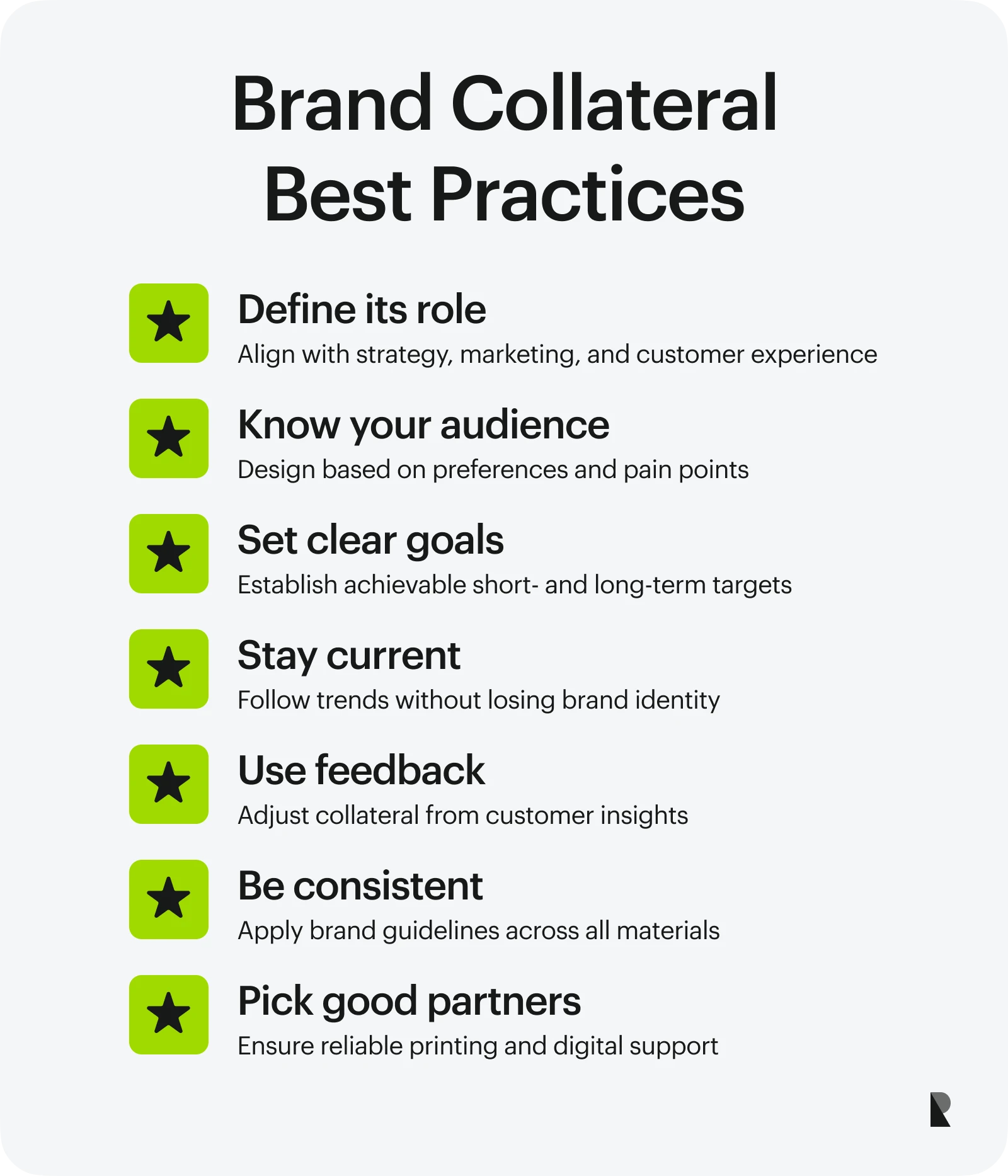
The primary challenge of introducing brand collaterals in branding is maintaining consistency with the brand identity while creating materials that effectively convey the brand message and cater to a diverse range of customer interactions. With over 30 different means of communication present in both the digital and physical worlds, unlocking the potential of this concept is truly overwhelming. Follow these professional recommendations to ensure it works across various formats and benefits the company as intended.
- Understand the role of brand material in your content marketing, advertising, long-term strategy, customer experience, and the company's growth and development.
- Inspect the target audience, gather their preferences and expectations, identify behavior patterns, and uncover pain points.
- Set the right goals for short- and long-term strategies. Ensure they are achievable and have reasonable deadlines.
- Track trends. Introduce new brand collaterals to follow the mainstream, but remain true to your company's personality, ideology, and mission.
- Listen carefully to your existing customers. Get relevant feedback and insights to adjust your brand collateral.
- Prioritize consistency: create a visual guide, educate your personnel, and minimize the learning curve for new teammates or freelancers.
- Find reliable partners who can provide printing and digital services. Ensure they can maintain brand collateral and provide you with timely updates.
Mapping Collateral to the Customer Journey
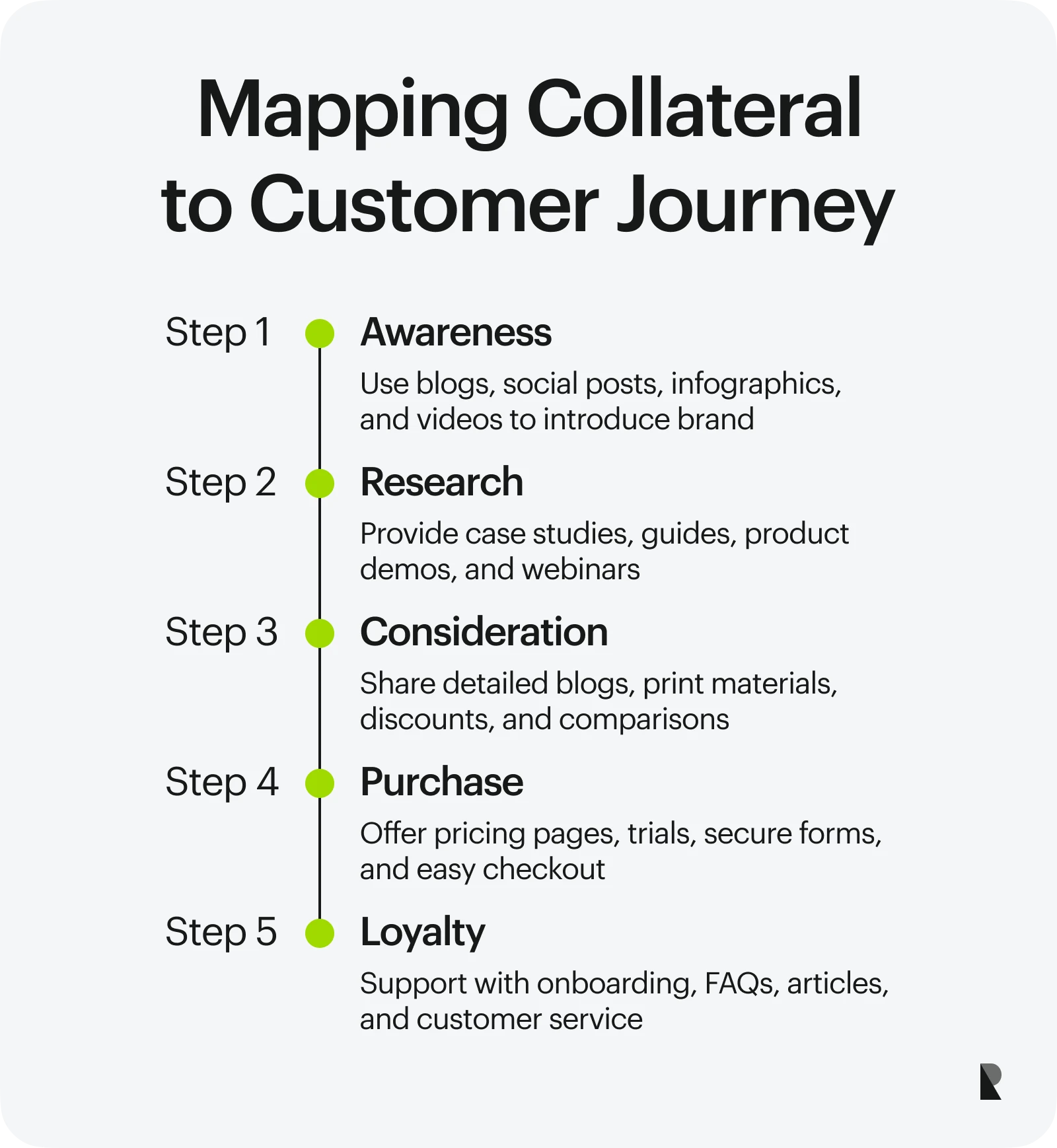
It is vital to map brand collateral accurately to every stage of the customer journey map, as this helps to make informed decisions, drive engagement, enhance customer retention, and ultimately generate revenue.
Throughout the buying journey, customers interact with the brand differently: through the user experience, in-store with a sales representative, on the digital website, while reading your blog, or interacting with customer support. Ideally, each touchpoint requires its brand collateral to work effectively and guide the customer through the process. Here is the breakdown of how to do this based on the typical customer journey stages.
Awareness
The first stage is when potential customers learn about your company and its products or services. It is when they realize they have a pain point to address or an opportunity to grab. This is your chance to make this introduction effective, meaningful, and impactful. Educate them about your offerings through blog posts, social media content, infographics, and explainer videos.
Research
Becoming aware of the need or opportunity, prospective customers research to collect relevant data for making an informed decision. While this stage is commonly used to gather valuable insights about customers' needs, preferences, and expectations, it is also an excellent opportunity to advance your brand by making it visible and meaningful. You can meet prospects' needs by providing comparison tables, case studies, guides, product demos, and webinars.
Consideration
This stage marks an active comparison process. Potential customers gather all the necessary information and attempt to determine the best option for their needs, budget, or deadline, leading to a more focused evaluation. Companies might help them with more detailed information, such as blog posts, print materials, or marketing ploys like discounts, giving them valid reasons to choose them over others.
Purchase
After considering options, customers enter the purchase stage when they are ready to decide and commit to the product by hitting the purchase button. This process must be seamless, unobtrusive, appealing, and straightforward. For this purpose, utilize pricing pages, contact information, free trials, and quick and secure order forms.
Loyalty
The final stage involves companies focusing on customers' loyalty, trust, and engagement, ensuring they will return, make repeat purchases, or become brand advocates. Here, you can help increase overall satisfaction with the product and brand by providing an effective support team and onboarding digital or printed materials, FAQs, and articles.
Conclusion
Brand collateral is a diverse asset that communicates the brand's vision, mission, message, and values. It creates a distinctive user experience at all interaction points, shapes the brand's image and perception, and plays a crucial role in the company's successful existence and growth.
With global digitalization, brand collateral has undergone significant changes, enriching its tools with online means that raise some challenges for companies in handling this concept and unlocking its potential to drive engagement, reinforce customer relationships, and improve retention.
To ensure that collateral and brand work together effectively, it is crucial to understand your brand personality, devise a visual style guide, prioritize clarity in delivery, efficiently adapt to different formats, and maintain consistency with the brand's identity and the target audience's needs and preferences.
Aug 8, 2025
